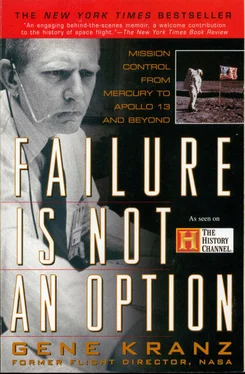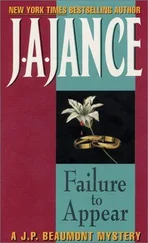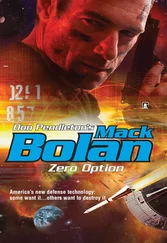The day after I arrived Paul Johnson and I went to the launch pad. I was shocked when I first saw the Redstone rocket. It was stark, awkward, and crude, a large black-and-white stovepipe atop a simple cradle. It had none of the obvious coiled power and distinctive personality of an airplane; it was not graceful in form, not something you could come to love and rely on. The Mercury capsule squatted atop the rocket, black in color and seemingly constructed of corrugated sheet metal. With its tall red escape tower it looked more like a buoy in a harbor than a rocket ship from a science fiction novel. Given the oil field-like setting in the wilderness and the crude appearance of the rocket, I felt more like a drilling rig roughneck than a rocket scientist when I made my way into the bar of the Holiday Inn that evening.
Putting any reservations aside, I plunged into working with Paul on defining the joint tests of control and communications systems, as well as the Go NoGo points for telemetry display, command, and communications in Mercury Control. My next step was to synchronize the Mercury Control Center (MCC) countdown with the capsule and booster countdowns. Paul Johnson returned to Langley to deal with a set of problems in the tracking network while I completed the work down at the Cape. To this day I feel enormous gratitude to Paul for giving me a running start. This was one of the critical moments in my life when someone stepped in and pointed me in the right direction.
I had left behind a world where airplanes were flying at roughly five miles a minute. In this new, virtually uncharted world we would be moving at five miles per second. During a mission countdown, or even a flight test, so many things would be happening so fast that you did not have any time for second thoughts or arguments. You wanted the debate behind you. So before the mission, you held meetings to decide what to do if anything went wrong.
You wrote down on paper the outcome of these meetings and this became what you needed for a launch, your personal list of Go NoGo’s. There was no room in the process for emotion, no space for fear or doubt, no time to stop and think things over. A launch is an existential moment, much like combat. With no time to think about anything, you had to be prepared to respond to any contingency—and those contingencies had to be as fully anticipated as possible before you pushed the button. You also had to be thoroughly knowledgeable about the responsibilities of launch control and range safety. During a launch the only mission alternative to save the capsule was an abort, and we had to pick the points to act before the range safety officer (RSO) stepped in to blow up the rocket and the capsule after launch if things went to hell.
By the end of the first week we had just finished the initial paperwork for the countdown procedures and mission rules, but had yet to run a simulated countdown. I was finally breathing easier. Johnson had taken me from Kraft’s few words on what he wanted done to a point where I finally knew what he was talking about. It was only some six days after my “rocket ride” with Gordo Cooper, but my job was starting to seem real to me. The few days of hands-on familiarity with MCC systems now tied into the concept of the MCC team. The MCC was coming together as a working reality. My newfound knowledge, while only paper thin, was as good as anyone else’s. It was now time to put it to the test. I called Kraft and said the countdown and the operational rules were ready.
Shortly before the rest of the team that would be involved in the first launch arrived from Langley, I made a thoughtful walk-through inspection of the relatively small—in comparison to later control centers—space that contained the operating elements of Mercury Control.
When a fighter pilot arrives at a base the first thing he does is go down to the flight line and look at the new airplane he is going to fly. You walk around it, feel the skin, climb up on the wing, and look in the cockpit, knowing that soon this airplane is going to be yours. It is a time when you feel a bit cocky, knowing that you are one of the few who will be privileged to live in this highly charged new world of high-speed flight.
I felt the same way on my solitary walk around the Mercury control room; I felt like I was meeting an airplane. I was, at long last, feeling at home. The telemetry, communications, and display areas were like the facilities at Holloman, but there was no counterpart for the control room itself. The room was square, about sixty feet on each side, dominated by a world map in the front. The map contained a series of circles, bull’s-eyes centered on the worldwide network of tracking stations. Below each were boxes containing many different and, for the uninitiated, unintelligible symbols. A toylike spacecraft model, suspended by wires, moved across the map to trace the orbit. On each side of the map were boards, where sixteen critical measurements were plotted by sliding beads, like those on an abacus, up and down wires as the capsule circled the world. In less than four years much of this technology would be obsolete—only the concept of Mission Control would remain. The meters and console displays would eventually be replaced by television displays driven by computers, which provided the controllers virtually instantaneous access to every bit (or byte) of the spacecraft’s data. Digital systems would enable ground control of the space systems. This would make it possible for controllers on the ground to work in partnership with a spacecraft’s crew to achieve the objectives of any flight. But this was yet to come; now we had to control the missions with fragile communications, a first-generation solid-state computer, slide rules, and guts. We were in the Lindbergh stage of spaceflight.
Given my aircraft test flight background, the control room felt vaguely familiar, with the exception of the three rows of consoles on elevated platforms. Each console was configured differently. Consoles on the top row were flat pedestals with communications boxes on top. When I first arrived at the Cape, Paul Johnson had taken me on a tour of the control room and pointed out the procedures console. I sat at the console, staring at the flat gray face and writing desk. The only instruments were a clock and an intercom panel with a rotary (!) phone at the top. This was the state-of-the-art work station that Paul and his colleagues from Western Electric had designed from scratch. It was on the left, in the middle row, and closest to the Teletype room. As I sat down at my console, two people came over and introduced themselves.
Andy Anderson, tall and skinny with long, sandy hair, was the boss of the communications center. His hotshot Teletype operator, a short red-head with a brush cut, was simply “Eshelman.” No one called him anything else. During a launch, I reeled off a running account of key data on the sequence of events to Eshelman, who typed them out and transmitted them by landline and radio links to remote tracking stations in Bermuda, Africa, Australia, and distant islands and ships in the Atlantic and Pacific. Eshelman had the skill and grace of a concert pianist as he stood, intently bent over the Teletype keyboard, interacting in real time with the Bermuda Teletype operator, just as if they were having a conversation. The tools we used in Mercury were primitive, but the dedication of highly trained people offset the limitations of the equipment available to us in these early days and kept the very real risks under control. But at a price; this was high-sweat, high-risk activity, demanding a degree of coordination between the ground and the capsule exceeding what I had experienced even in the testing of experimental aircraft.
During the next two years, Anderson, Eshelman, and I controlled virtually all the Teletype message traffic originating from Mercury Control at the Cape. This was the heart of the ground control system, tied to that tenuously linked chain of tracking stations and manned remote sites by a variety of communications systems. Low-speed Teletype provided the backbone, and the controllers became adept at moving messages rapidly between the tracking sites as the spacecraft passed overhead.
Читать дальше












